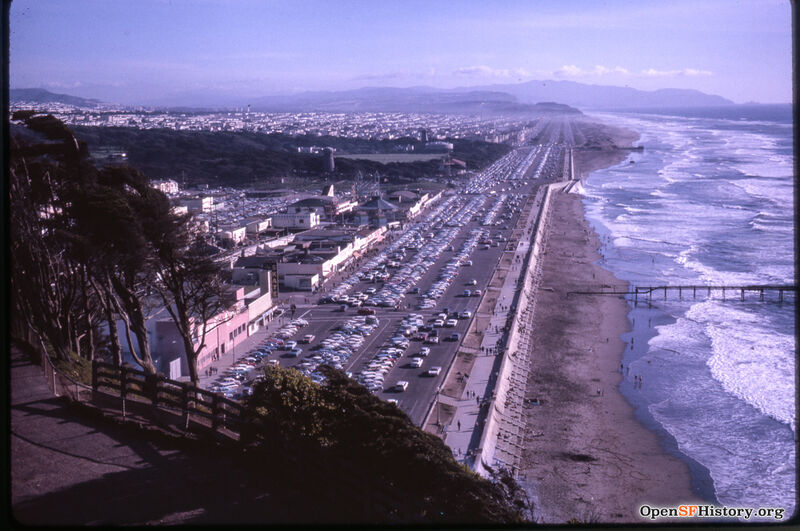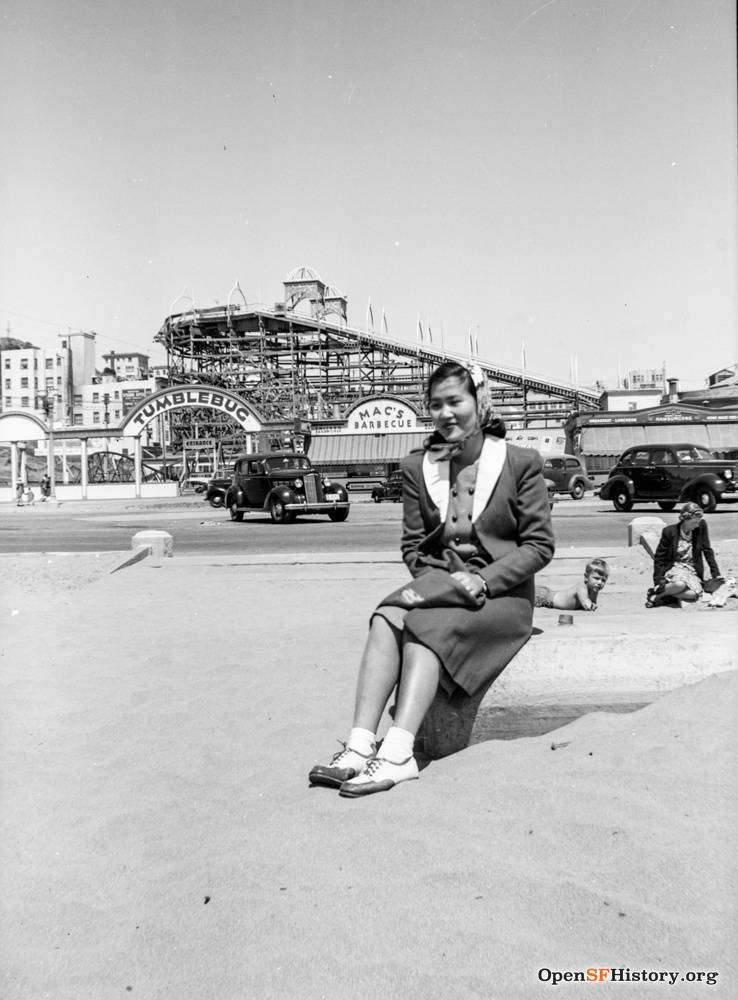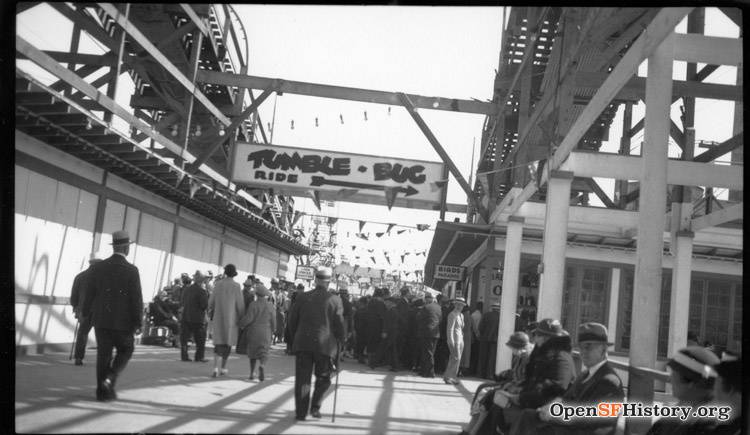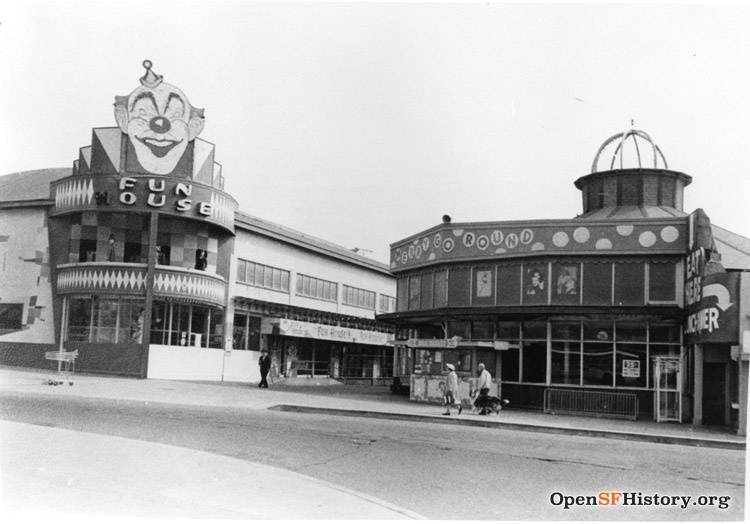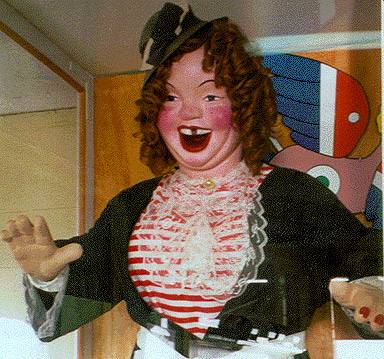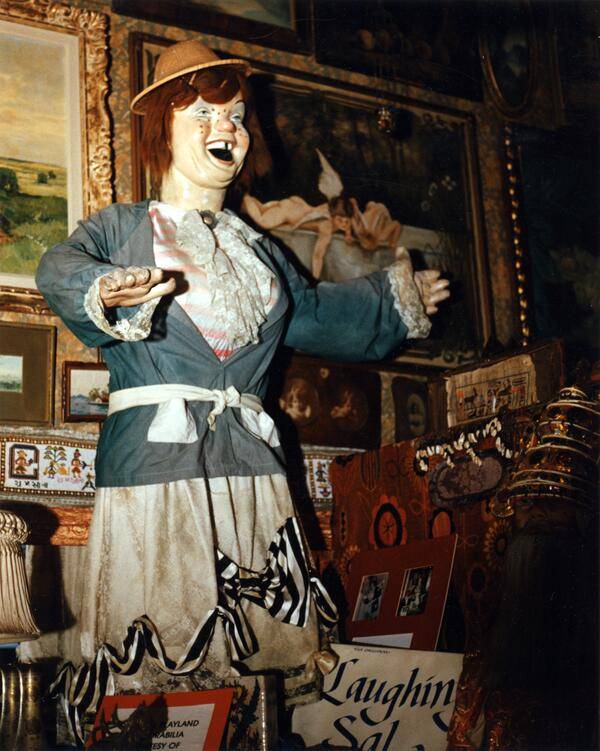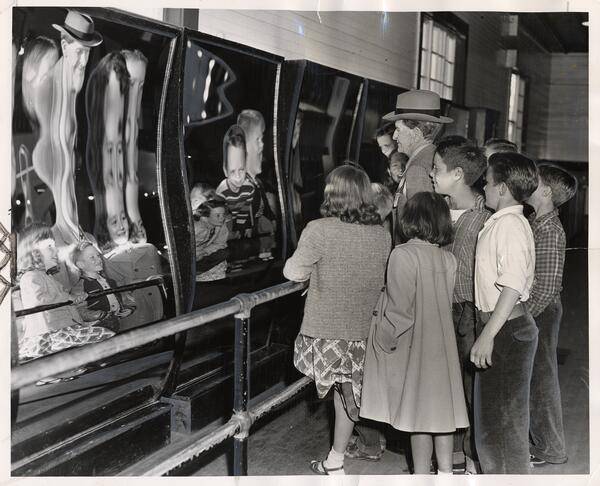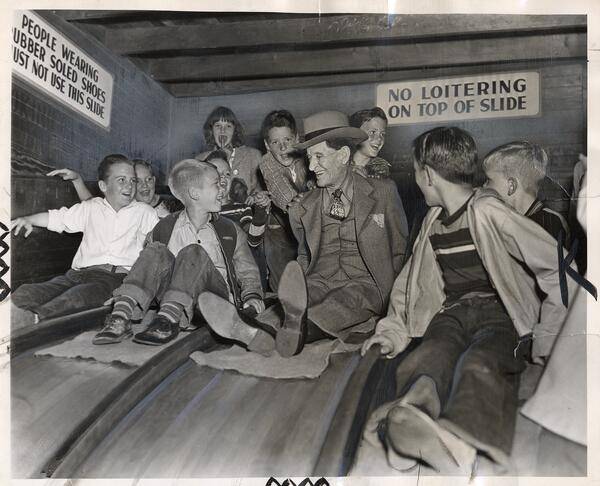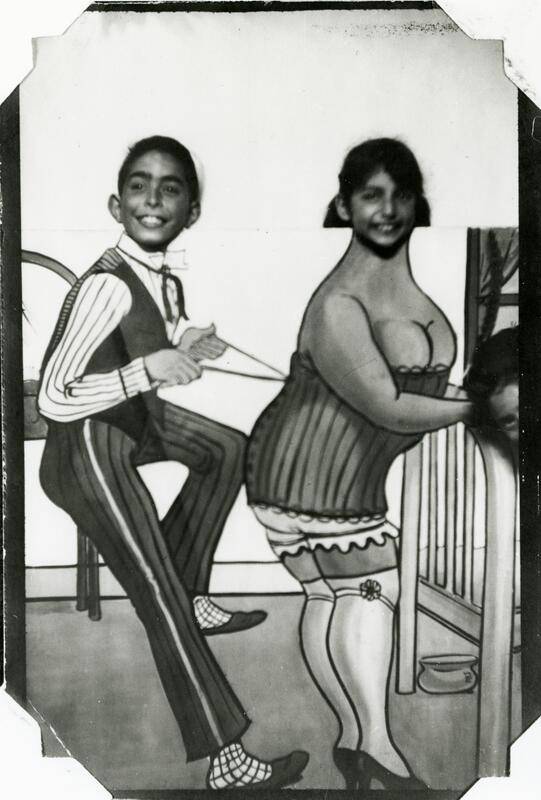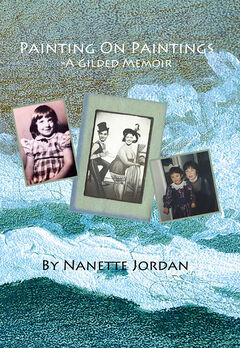Playland is a Nightmare: Difference between revisions
mNo edit summary |
m (Protected "Playland is a Nightmare" ([Edit=Allow only administrators] (indefinite) [Move=Allow only administrators] (indefinite))) |
(No difference)
| |
Revision as of 13:36, 10 January 2023
I was there . . .
© by Nanette Jordan, 2020, from Painting on Paintings: A Gilded Memoir
This story is continued from Part One.
The memories in this story are in an adult’s “voice” looking back at a child’s experience... The adult doing the remembering is me... The child was also me…
View south from Sutro Heights over Playland at the Beach, Ocean Beach, and Golden Gate Park, c. 1963.
Photo: OpenSFHistory.org wnp25.2891
Unknown young woman on the Great Highway near Balboa Street, across from Playland at the Beach.
Photo: OpenSFHistory.org wnp14.4785
Though I now feel complete, my sweater, damp from fog, chills me to the bone as I head down the long hill that winds up at the same empty Ocean Beach, next to which stands “Playland,” the real “Playland.” It is barely frequented, and only by a smattering of uniformed sailors on occasional shore leave. A few have girlfriends who covet sawdust-filled bears.
I quickly run under Playland’s flimsy wooden roller-coaster, which doesn't look too different from the one made of toothpicks. This real-life roller coaster’s wooden scaffolding creaks in the wind that comes in off the ocean. Empty metal two-passenger bucket seats with their patches of worn red paint, dangle. The seats bang and clang into one another.
Playland at the Beach, under the rollercoaster, c. 1927.
Photo: OpenSFHistory.org wnp4.1036
Flimsy shacks in a long row are hastily nailed to one another, and each makes the next one lean more than the one before. Some are empty, but a few are adorned with hanging sawdust-stuffed bears one believes one can easily win in exchange for knocking over a weighted dummy. The dummies never get knocked over no matter how good your aim is, even the aim of a sailor. Milk bottle coin toss is also impossible. It only takes me one visit of losing my corn dog money to save my change for Playland food, the favorite of which is a sticky brick of pink popcorn wrapped in clear cellophane.
Playland at the Beach, c. 1955.
Photo: OpenSFHistory.org wnp4.0952
On my way to the Funhouse, I pass the giant hammer. A painted sign with an absurdly oversized ruler reads, “Must Be 18 Years Of Age…Or THIS Tall.” Next to that, a small, faded billboard depicts a cartoon of a muscle-man kicking sand at a skinny guy while a pretty girl stands nearby the brute laughing. At the top of the hammer game, is a picture of one huge tattooed arm that says “mother.” The pretty girl from the bottom picture is in the top picture too. Neon hearts come out of her head.
Now a sailor in white stands in the ready with his girl nearby who is wearing a poodle skirt. He wants to show her how strong he is. Like “Popeye,” he hoists the oversized hammer back and over his head, slamming the hammer down onto a small painted bullseye as hard as he can. A lit-up red bulb flies up a giant thermometer. A loud bell rings. He wins a small chalk-ware Kewpie Doll for his girl who’s squealing and hugging his scrawny arm.
At the entrance of the Funhouse, behind glass, a gigantic animated fat-lady doll with huge dust-covered red yarn ringlets turns her head slowly to the right, then slowly to the left. She wears a ruffled pinafore with red stripes, and underneath are red bloomers with exaggerated white polka dots. She has painted-on freckles, widely spaced teeth, a round pig-nose, and her mouth opens and closes as she throws her head back, hideous laughter blaring on a loop. When she leans her head forward, she looks down directly at me, leaving me looking into her large laughing open mouth with its fat pink tongue and dangling red epiglottis.
I don’t understand her purpose as the doorwoman of the Funhouse, particularly since she isn’t funny. Nevertheless, her name reads simply, “Laughing Sal.”
Laughing Sal
Photo: Chris Carlsson
Laughing Sal
Photo: San Francisco History Center, SF Public Library, AAB-0158
<iframe src="https://archive.org/embed/LaughingSal" width="500" height="40" frameborder="0" webkitallowfullscreen="true" mozallowfullscreen="true" allowfullscreen></iframe>
That laugh mixes with loud screaming coming from inside the Funhouse. Once in its ante-room, there is a smell of gasoline and burlap presumably from car repair garages who pass on their rags after they have mopped up oil left behind by cars. Now the car rags are piled inside the main room of the Funhouse. The Hall of Mirrors is next. The mirrors stretch my body so that I appear fat with a monster head and elephant ears. Stepping to the side, I’m thin as a pencil with just a large protruding nose. Next comes an impossible maze, every wall down every hall a mirrored dead-end. A mother and son enter and, after his numerous “tries,” she guides the boy through before he can lose his composure and kick a mirror. I follow them. No sooner is one out of the safe harbor of the maze of mirrors, when one must suddenly squeeze between many menacing cloth-covered drums spinning out of control and too close together, each the size of a small car. The falsely whimsical “circus” painted canvas cloth around each of these drums camouflages metal frames within. Squeezing through leaves bruises on children. Motors as loud as jet engines roar under the entire floor of the Funhouse. One cannot proceed past any obstacle without overcoming it first.
Funhouse Mirrors at Playland
Photo: San Francisco History Center, SF Public Library, AAB-9977
The same floor also deceptively hides tiny holes, which periodically erupt with angry pencil-thin jets of hot air accompanied by ear-spitting air-blast noises. No one can escape these. A villain watching from a glass booth on high lies in wait until small children below pass over a floor hole. He pulls his crank good and hard, causing a sudden targeted explosion of hot air to stupefy any child. Even every sailor tries unsuccessfully to guide his girlfriend expertly over floor holes. The explosive air seems timed to blow up any skirt to reveal all tops of all stockings and the girdles holding them up.
Next are wooden bridges skimming the floor, swinging back and forth, back and forth. These are right next to planks that roll up and down in waves. A jump across from one moving floor to the next at the wrong time may result in falling into a space between the moving floors and being crushed by them. The only way across is to hug the rail with both arms and take baby steps while being thrashed violently back and forth, up and down, finally leaving one’s little forearms full of splinters.
Now I venture over to the bottom of a set of six giant wooden slides, a stairway at the side looming up as far as the eye can see and even beyond. I grab a burlap bag that has a picture of potatoes on it. I will be seated upon and sliding down on this half-torn bag. It is what smells like old car engines and gasoline…. And now, so will I.
Charles Coryell with a group of children from his neighborhood at Playland, c. 1940s.
Photo: San Francisco History Center, San Francisco Public Library, AAB-9981
Kids are like ants carrying their burlaps up the ever steeper narrow stairs flanking the line-up of slides, their wooden surfaces gleaming under industrial lights. Looking up, I cannot see the top from the bottom. Soon, I will barely see the bottom from the top.
Children change their minds. Mothers squeeze past the line of children on the way up, grab their bawling child, then reverse the process wending their way back down the same stairs. A few mothers, exasperated, continue to the top landing, putting children on laps, pushing off, as their children wail in terror all the way down. Once at the bottom, safe and sound, no sooner will mothers have finished wiping noses, but one last angry air blast puts the period at the end of the Funhouse slide “sentence.”
For my part, the long, steep slide picks up speed on the trip down, my hands getting burns from the wooden slide’s divider ridge. Soon, I, too, want to change my mind at the exact moment that I hit a wavy bump, which flings me unceremoniously into the air, all wind knocked out of me, as I gasp on the rubber floor at the bottom just in time to be landed upon by the child sliding next behind me.
Lastly, the greatest funhouse challenge of all: a jumbo flat shiny wooden “record,” fifteen feet across, ready to begin its spinning! Kids burst out of nowhere scrambling to sit dead center as do I. Bigger kids shove smaller kids out of the way. The “record” starts to spin, slowly at first. Children going around and around are smiling. Parents who watch are smiling. Spinning faster and faster, the room becomes a blur, the pace dizzying. I donʼt want to be the child who throws up.
Small kids fly off first, landing hard onto the rubber floor which smells like tires on fire at the dump. Soon, I feel the inevitable slippage of my hard-won position near the middle. Like all other children, I inevitably slide off the spinning menace and onto the floor as well. No sooner do I stand, but children are thrown hard right on top of me and onto each other forming a great screaming pile of arms and legs. Wounded, we each gather ourselves, wipe a nose with a sleeve, stand, one loser at a time, turning to face the spinning wooden “record,” and on it, a single over-large freckled red-haired beefy child remains, dead center, triumphant!
I am done. It will be dark soon as I depart Playland to catch my bus. Even so, I can’t resist popping my head in at one last concession, the sign reading, “Souvenir Photos.” The entrance is a wide metal roll-up door that is, in fact, rolled up. Inside, a bored cashier should have retired long before regret and disdain set in. The cashier wears a flowered, overly cheerful, overly big Hawaiian shirt. The cashier’s worn face has a sparse mustache. I am confused. Is he a she, or is she is a he? We don’t speak, but the cashier’s narrowed eyes follow me and want me gone.
This only encourages me. I look around and see that there are three painted wooden scenes each standing by itself on its own platform, and each featuring a different painted scene with two head-holes cut out for two faces to look through when one stands behind, posing for a photo. Below each head-hole is a picture of a body.
Two children posing for portraits between 1945-49 at Playland.
Photo: San Francisco History Center, San Francisco Public Library SFP78-002-320
Another Funny Foto at Playland.
Photo: San Francisco History Center, San Francisco Public Library AAB-9982
One painted scene is tropical featuring two fit bodies dressed in old-fashioned bathing attire, the couple holding tropical drinks accented with miniature umbrellas. The paint is worn. People like that one. The second painted scene depicts a motorcycle speeding along. Aboard are two headless bodies each dressed in leathers from the neck down, her jacket flown open to reveal an ample cleavage. One of her high heels has flown off behind the motorcycle. His well-developed bare forearms sport tattoos. The last of the three painted scenes is clearly inside a bedroom. The “wife” has a huge bosom overflowing a too-tight corset under which peeks ruffled underthings and, further, under those, her plump legs squeezed uncomfortably into stockings. She bends forward steadying herself on the brass railing at the end of a bed. The cut-out head-hole for the face of the woman in the scenario is topped by a be-feathered be-flowered hat. The “husband” stands behind her. He is already dressed for the evening’s festivities, sporting a dress shirt, ribbon tie, pants with stripes up the sides, and spats. Above his cut out face-hole he wears a jaunty black top-hat. His job is to help her into her corset, thus he holds the two laces of the corset from behind, pulling them tightly.
Then I notice, in this scene, there is a little window painted into the bedroom, and, looking through it, a gaga-eyed “peeping Tom!”
As I tauntingly walk ever so slowly toward the wide exit, I notice a flat glass case on the wall. In it are sample photos left behind by the individuals who were in the photos. The corners of the photos curl. Perhaps the people posing didn’t like them and left in a huff. Taking my good sweet time absorbing each and every photo, I sense I’m more than not welcome anymore. Still, I take in every photo of every face of every couple atop every body painted onto every picture of every standing wood scenario.
The flowered “ladyman" tells me to go away. “You’re bad for business!” she grumps.
“What business?” I ask, looking around. It’s a battle of wits now that I’m not wanted.
And there, in the bottom-most right corner of the glass case filled with photos of happy couples putting their heads through holes above painted scenarios, can it be??? Is it possible??? Yes! It’s my parents!!! I am overcome. My eyes are wide. My heart is beating. I want that picture!
I tell the cashier this, that I want that picture. She tells me she’s going to call the cops. I well up with tears. I tell her, “This picture is mine!” Now she picks up the receiver of her black phone holding it to her ear. I am full-on crying. She is stone-faced and moves her finger into a dial hole, pausing, and her grimace is staring me down.
She wins. I will go away. But not before taking my hard-won pink popcorn, unwrapping its cellophane wrapper, dropping the perfectly formed sticky brick right in the middle of the entranceway of the photo concession, and, finally, crushing each and every gaudy pink kernel and gooey puff into the ground with the rubber heel of my Converse High-tops.
- Afterword: Fifty-five years later, my mother passes at age ninety-six. And there, amongst her papers and bills and receipts and letters and old business cards, I find a photo of my parents at the photo concession in Playland, my jaunty father tightening the corset strings of my pleasingly plump mother, while a “peeping Tom” looks on through the bedroom window….
Originally published in Painting on Paintings: A Gilded Memoir, 2022. Excerpted with Nanette Jordan's permission.

